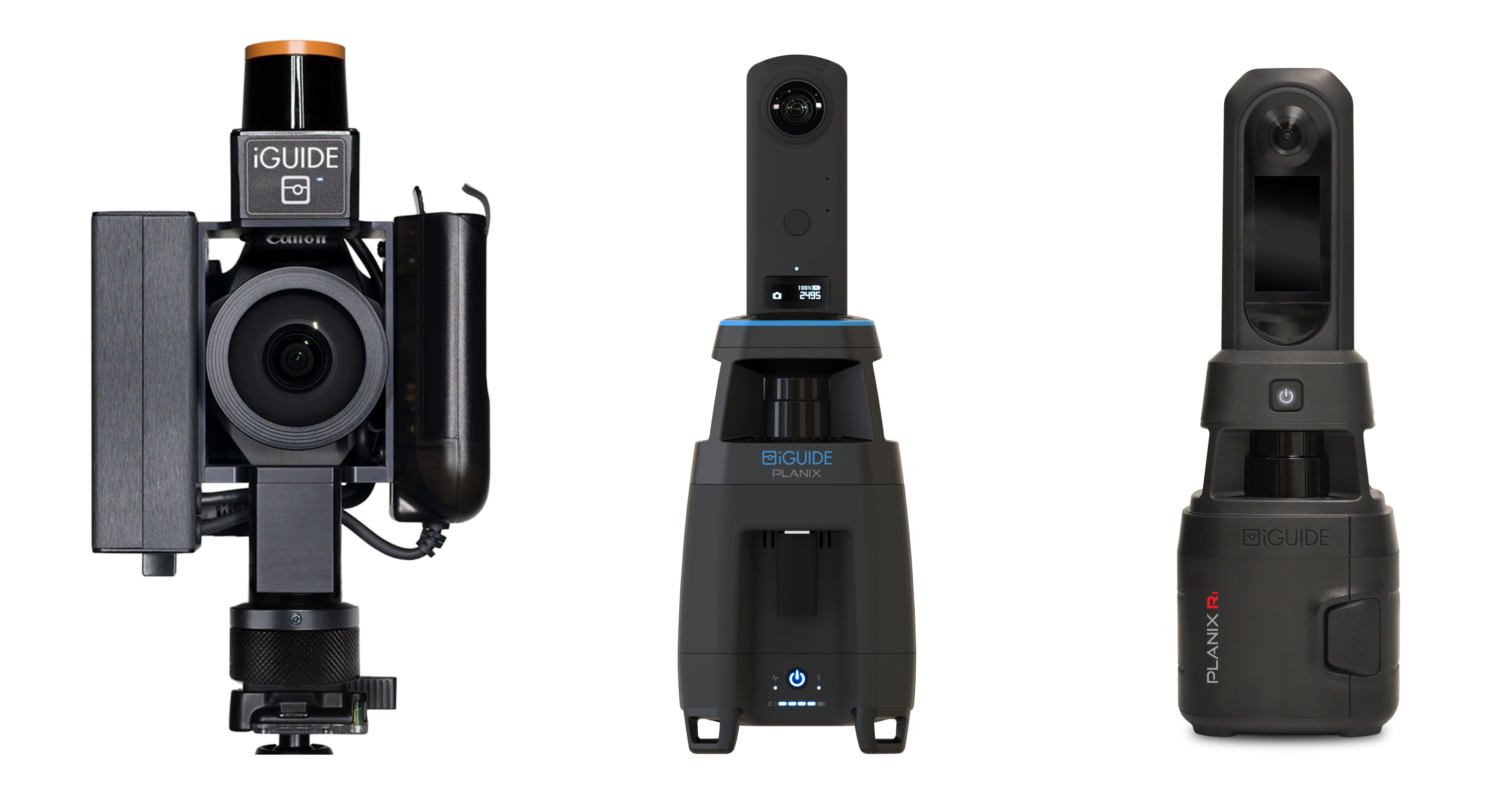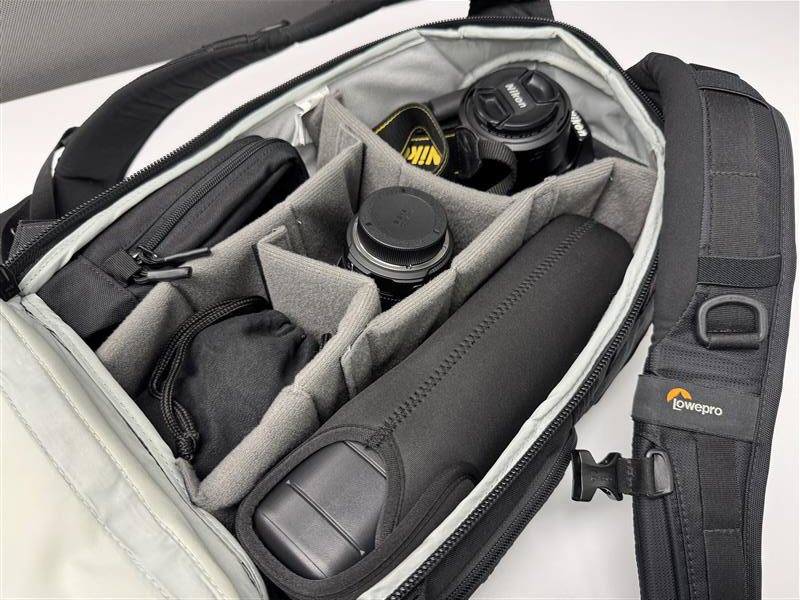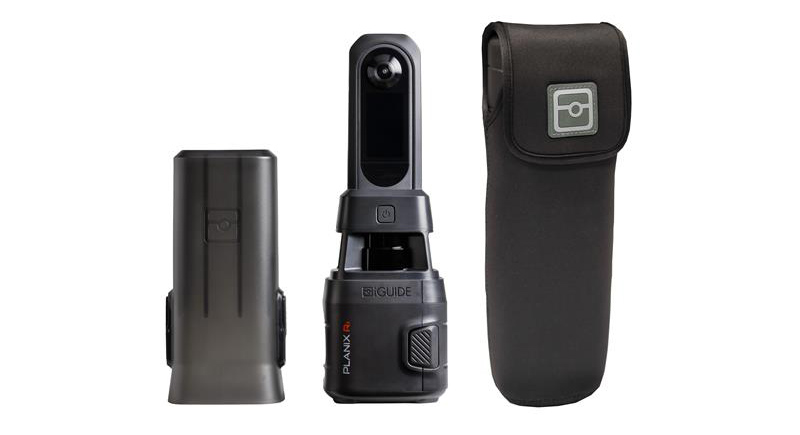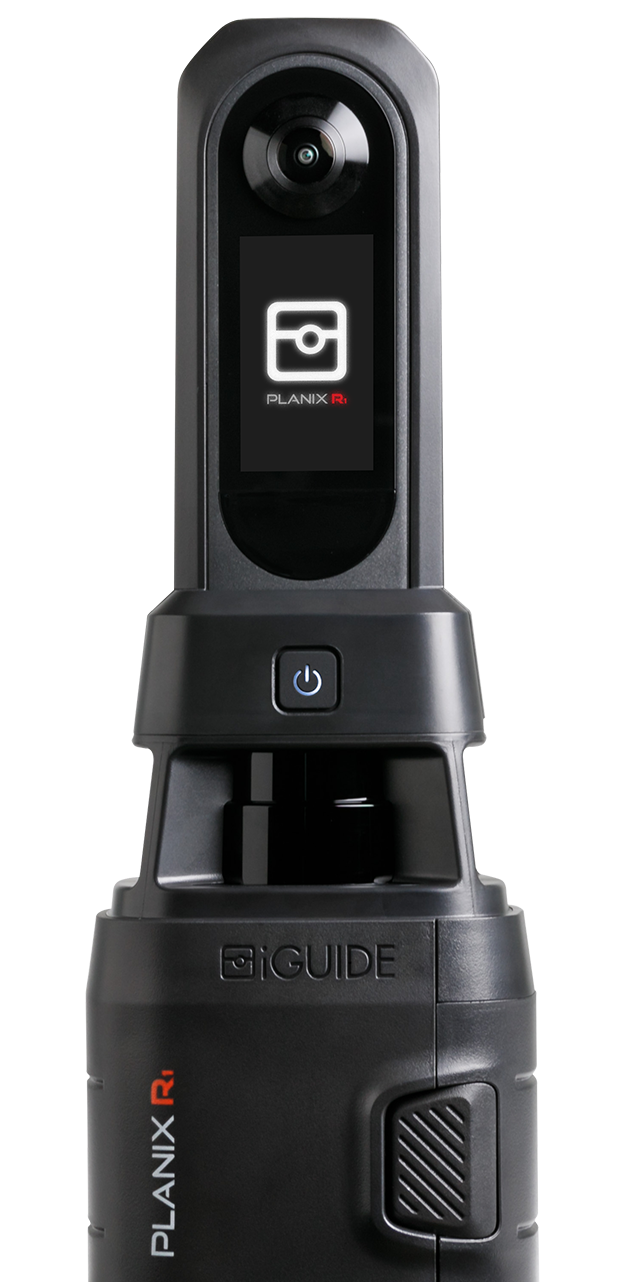As an existing iGUIDE user, you may wonder if this latest camera system suits you. We’ll answer that question by examining the key differences between PLANIX R1 and its predecessors.

From left to right: IMS-5, PLANIX Pro and PLANIX R1
Image Resolution
|
IMS-5 |
PLANIX Pro |
PLANIX R1 |
|
|
Inherent pano resolution |
20MP (due to lens) |
23MP |
60MP |
|
Integrated camera |
Canon T100 |
Ricoh THETA Z1 |
Ricoh THETA X |
|
Improvement over last generation |
N/A |
Slight improvement |
2.6X more pixels |
The iGUIDE camera system's image resolution has increased with each new generation. This can be experienced when zooming in on a detailed part of the tour.

From left to right: IMS-5, PLANIX Pro and PLANIX R1
As you’ve seen, the PLANIX R1 is the clear winner regarding the number of pixels it can leverage. This results in a real-world improvement in visual detail displayed in the iGUIDE virtual tour images.
Size & Weight
Generally speaking, the smaller and lighter the camera, the more convenient it is to use. Let’s evaluate the size and weight of each iGUIDE camera system:
|
IMS-5 |
PLANIX Pro |
PLANIX R1 |
|
|
System unit weight |
2.4 kg (5.2 lbs) |
980g (2.16 lbs) |
725g (1.76lb) |
|
System unit dimensions |
6.0" x 6.2" x 9.7" |
4.3” x 4.3” x 13.4” |
3.9" x 3.1" x 11.4" |
|
Improvement over last generation |
N/A |
59% lighter, 31% smaller |
26% lighter, 44% smaller |
The PLANIX R1 wins here with its smaller size and lighter weight when compared to previous generations, making it easier to carry and use, especially for multiple shoots in a single day.
Speed
All iGUIDE camera systems are tweaked to be as fast as possible within the limits of their technologies. Scan times referenced in the table below represent the time between tapping the shoot button and being able to pick up the camera and move it to the next scan position.
|
IMS-5 |
PLANIX Pro |
PLANIX R1 |
|
|
HDR scan time* |
18 seconds |
13 seconds |
8 seconds** |
|
Improvement over last generation |
N/A |
28% faster |
38% faster |
*Capture time varies with lighting conditions and camera settings.
** Noise reduction set to Low. NR set to Off can be as fast as 4s.
The extra time that PLANIX R1 saves you can be used in a variety of ways:
- Shoot 2-shot mode for the price of one-shot mode
- Increase noise reduction for smoother images
- Shoot more scans and make a more comprehensive virtual tour
- Spend more time capturing still images or video
Or... use the time savings to schedule and shoot more listings in a single day!
The experience of using the PLANIX R1 is similar to previous iGUIDE cameras with two interesting differences.
- The image preview for PLANIX R1 is available almost immediately.
- Processing and saving data to mobile device is also done while shooting takes place – which means uploading onsite can be done in a few minutes!
The PLANIX R1 wins again by being noticeably faster per scan and in operation, which translates into faster overall capture, leaving time to do more!
Carry case & transport
The PLANIX R1 has a new carrying case that is smaller and lighter and can carry more by using its internal space more wisely.
|
Volume* |
IMS-5 |
PLANIX Pro |
PLANIX R1 |
|
Exterior |
30,192cc |
19,227cc |
11,172cc |
|
Useable interior |
6,000cc |
5,000cc |
4,500cc |
|
Camera system |
5,000cc |
3,500cc |
2,500cc |
|
Extra |
1,000cc |
1,500cc |
2,000cc |
|
Improvement over last gen |
N/A |
50% more extra space |
33% more extra space |
*All volumes are approximate.

From left to right: IMS-5, PLANIX Pro and PLANIX R1
But wait, there’s more. You can use almost any bag or case you already have for PLANIX R1. It was designed with a special System Shield that covers the lenses, LiDAR sensor and power button. With the System Shield installed, you can carry it in almost any bag you’d like – which means one less thing to carry! This is also useful for air travel because the camera system can easily be placed into carry-on luggage, especially if using the included neoprene sleeve.
The winner... the PLANIX R1 because of its roomy carry case and its ability to easily ride in almost any bag/case that can accommodate its exterior dimensions.

PLANIX R1 in a bag alongside other gear.
Unique for PLANIX R1
PLANIX R1 has new features not present in previous generations meaning direct comparison isn’t possible.
System Shield
The System Shield is a unique, rugged cover that protects the camera’s critical components. It covers the RICOH Theta X lenses, the LiDAR sensor and the power button. This extra protection is intended to translate into a long service life and makes the system an everyday carry that you can always have at the ready.

System Shield + Neoprene Sleeve
Noise Reduction
PLANIX R1 has low, medium and high noise reduction settings to smooth images. It works by capturing multiple images and then combining them to make a final output that exceeds the performance of what the camera’s sensor could natively create.

Noise reduction.
Static or Dynamic stitching
Static stitching can be chosen to significantly increase the optimal measurement accuracy area in on-screen Measure Modes 2 and 3 (not greyed out). If you plan to use Measure Modes 2 or 3, you’ll need fewer scans to comprehensively capture a space for subsequent measurements in images.
|
Camera System & Setting |
Measure Mode 2 & 3 (Masked field of view) |
|
PLANIX Pro |
60º |
|
PLANIX R1 (Dynamic Stitching) |
60º |
|
PLANIX R1 (Static Stitching) |
3º |

Dynamic Stitching mask vs. Static Stitching mask
Dynamic stitching can be chosen to make stitching artifacts less visible. This should be selected when marketing is the primary goal of the 3D virtual tour, whereas static stitching is recommended for engineering and architectural uses.
Smart device storage
PLANIX R1 seamlessly utilizes your smart device's storage with existing workflows. For those using Stitch, project data is stored in an accessible folder, manageable like removable storage. You can transfer files to your computer wirelessly (e.g., AirDrop) or via USB or upload directly to the iGUIDE Portal, eliminating the need for export to your computer. You can also connect a USB storage device to your phone directly (formatted appropriately for your mobile device) to archive project data in the field.
Indoor tracking
The PLANIX R1's LiDAR scanner does more than measure - it tracks the camera's position in real-time, acting like indoor GPS. This feature accelerates new user training by helping them understand their camera position and the data represented on-screen, leading to improved camera placement and auto-alignment.
Easily obtainable battery
The PLANIX R1 uses a commonly available Milwaukee M12 Red Lithium High Output 2.5Ah battery (Model Number: M12 HB2.5, 48-11-2425). This battery is available at many hardware stores and can be obtained very quickly and for a lower cost than the batteries used in PLANIX Pro or IMS-5. Using any M12-compatible battery other than the one listed above is not supported.
Compare for yourself
The best way to see the differences between camera systems is to look at a 3D virtual tour created with each. Below, you will find a tour created with each using a consistent set of parameters.
- Sample property captured with IMS-5
- Sample property captured with PLANIX Pro
- Sample property captured with PLANIX R1
The PLANIX R1 example found above was shot using Static Stitching. Stitching artifacts may be present that would not have been present if Dynamic Stitching were used.
Should I replace my current iGUIDE camera system?
PLANIX Pro user: We recommend comparing the same virtual tours and deciding if the upgrade is worth it based on the output. The features outlined above are clear wins across the board for PLANIX R1, but PLANIX Pro is still an excellent camera system that can capture a property quickly, efficiently and accurately. For many current iGUIDE PLANIX Pro users, the PLANIX R1 is a great new camera when your business grows rather than a replacement for PLANIX Pro.
IMS-5 user: If you’ve been waiting for something to replace your aging system, the PLANIX R1 is an excellent choice. It offers massive advantages over IMS-5 in image quality, lidar range (40m vs 10m), usability and speed. The PLANIX R1 is a worthy replacement for IMS-5 at any time.
The bottom line
Compared to its immediate predecessor, the PLANIX R1 is 26% lighter, 44% smaller, 38% faster, has more than twice the resolution, increased durability, a more practical carrying case, an easily obtainable battery and new features such as noise reduction and indoor tracking. It is the best-performing, most advanced and easiest-to-use iGUIDE camera system ever made.
At the end of the day, the goal of every iGUIDE camera system since inception remains the same—helping users to efficiently and accurately digitize physical space, saving time, cutting costs and helping grow their business.
To learn more about the PLANIX R1, please schedule a demo with an iGUIDE Specialist.


